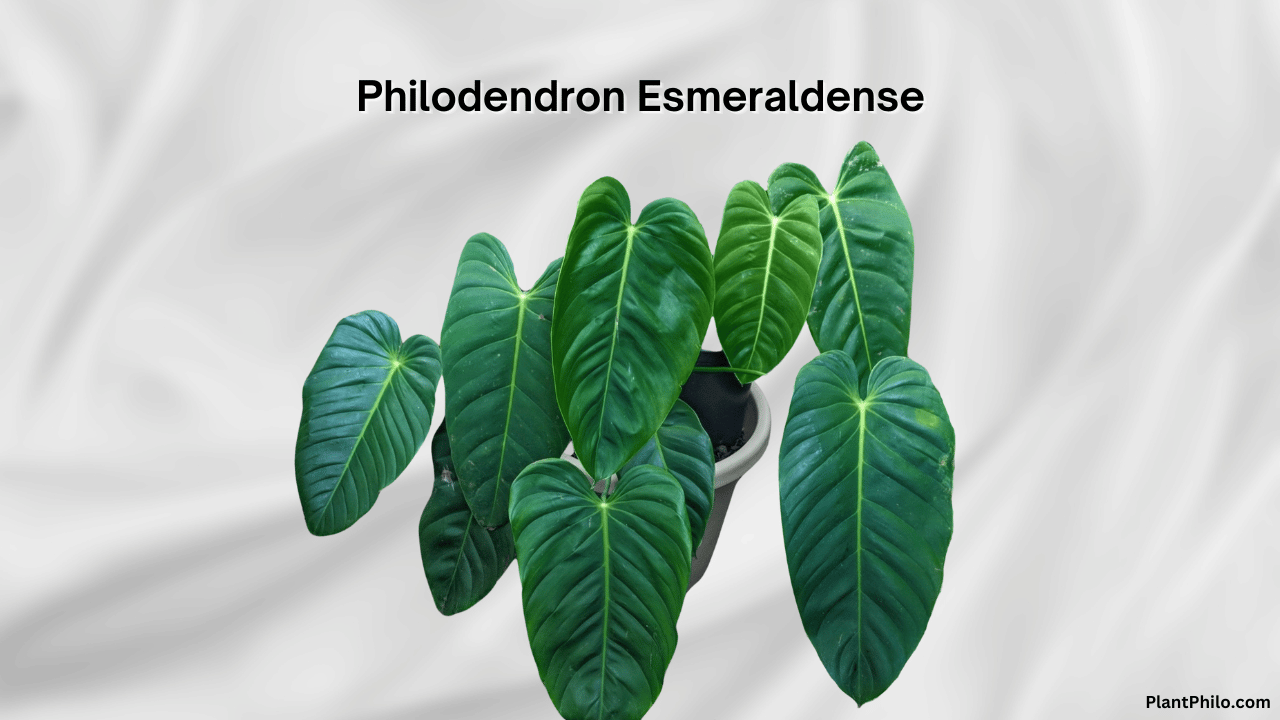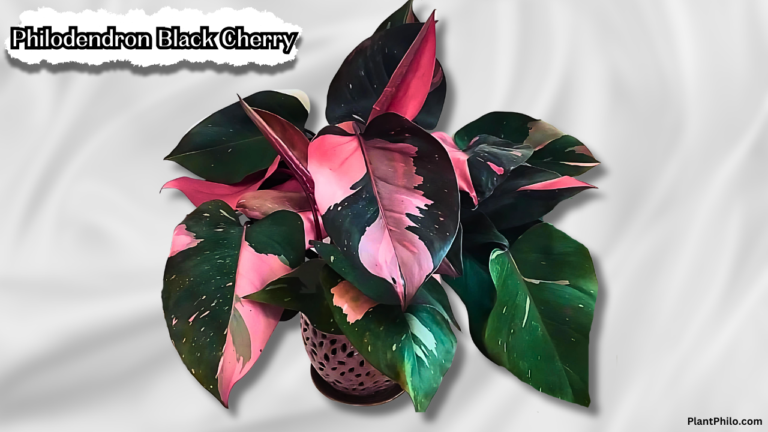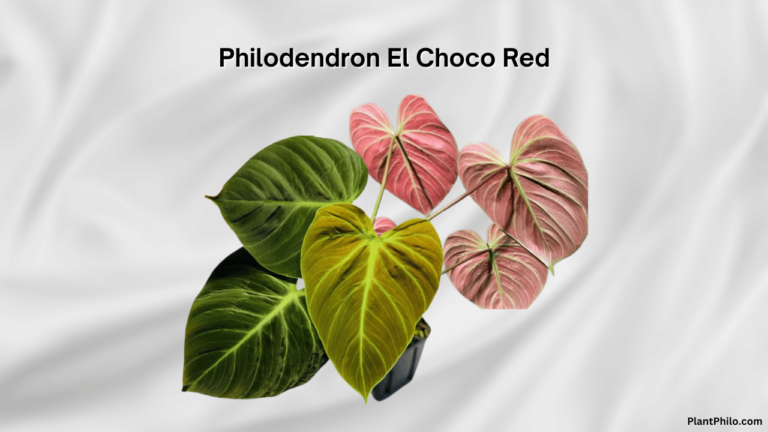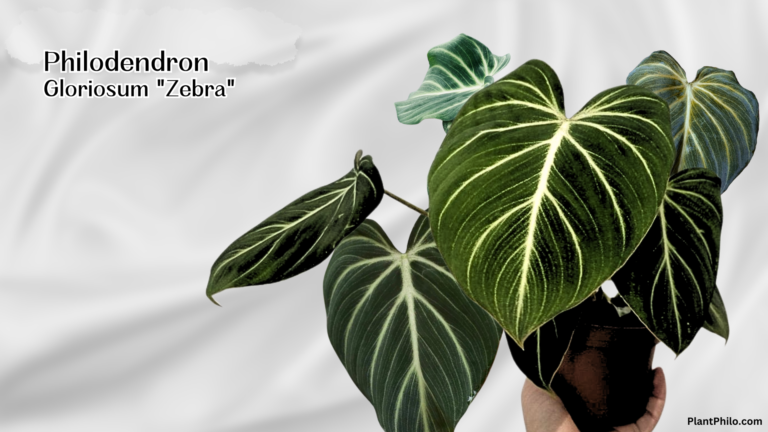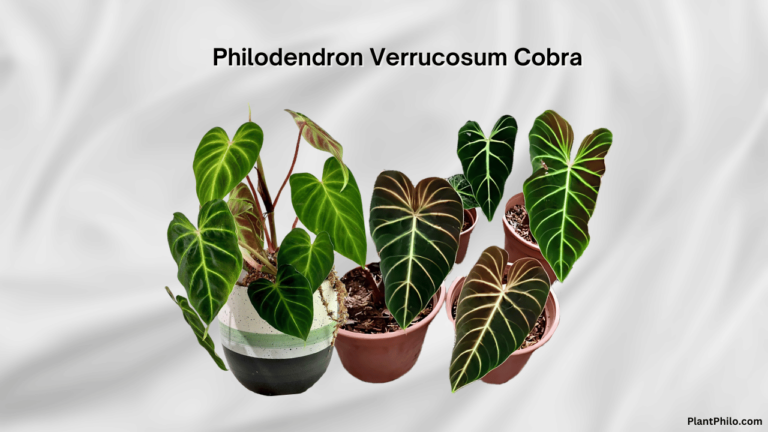Philodendron Esmeraldense: Care tips, Propagation techniques etc
Did you know that the Philodendron genus contains over 489 scientifically recognized species, with potentially hundreds more yet to be discovered? Among these botanical wonders, the Philodendron Esmeraldense stands out as a true emerald gem, captivating plant enthusiasts with its striking foliage and exotic allure. This rare beauty, hailing from the lush rainforests of Ecuador, has been turning heads in the horticultural world since its discovery in 2000.
Philodendron Esmeraldense, aptly named after the Esmeraldas Province in Ecuador where it was first found, is a testament to nature’s artistic prowess.
With its deep green, velvety leaves that can grow up to 3 feet long and 1.5 feet wide, this plant is not just a visual spectacle but also a botanical marvel. Its rarity in cultivation makes it a prized possession for collectors and a challenging yet rewarding project for passionate gardeners.
As we delve deeper into the world of Philodendron Esmeraldense, we’ll explore its unique characteristics, care requirements, and the joy it brings to those fortunate enough to nurture one.
Whether you’re a seasoned plant parent or a curious newcomer to the world of rare aroids, this guide will equip you with the knowledge to help your Esmeraldense thrive and potentially become the crown jewel of your indoor jungle.
Information Table: Philodendron Esmeraldense
| Feature | Details |
| Scientific Name | Philodendron esmeraldense |
| Origin | Tropical rainforests of Ecuador |
| Common Names | Emerald Philodendron, Esmeralda Philodendron |
| Growth Habit | Climbing/Vining |
| Leaf Shape | Elongated, lance-shaped, leathery texture |
| Leaf Color | Deep green with prominent veins |
| Light Needs | Bright, indirect light |
| Temperature Range | 60 °F to 80 °F (15 °C to 27 °C) |
| Water Needs | Allow soil to dry out slightly between watering |
| Humidity | High humidity (60-80%) |
| Soil | Well-draining, airy mix rich in organic matter |
| Fertilizer | Balanced liquid fertilizer during the growing season |
| Propagation | Stem cuttings |
| Pests & Diseases | Susceptible to common houseplant pests and root rot if overwatered |
| Toxicity | Toxic to pets and humans if ingested |
The Natural Habitat: Understanding Its Roots
To truly appreciate and care for Philodendron Esmeraldense, we must first understand its natural habitat. This magnificent plant is endemic to the Esmeraldas Province in northwestern Ecuador, a region known for its biodiversity hotspots and lush tropical rainforests. Here are some key facts about its native environment:
- Climate: The Esmeraldas Province experiences a tropical monsoon climate with average temperatures ranging from 70°F to 85°F (21°C to 29°C) year-round.
- Rainfall: The area receives substantial rainfall, averaging 2000-3000 mm (78-118 inches) annually, with a slight dry season from July to December.
- Elevation: Philodendron Esmeraldense is typically found at elevations between 100 to 600 meters (328 to 1968 feet) above sea level.
- Soil Composition: The soil in its native habitat is rich in organic matter, well-draining, and slightly acidic with a pH range of 5.5 to 6.5.
Understanding these environmental factors is crucial for replicating optimal growing conditions in your home or greenhouse. As the saying goes, “To know the plant, you must know its home.”
Distinctive Features: What Makes Esmeraldense Special
Philodendron Esmeraldense is a show-stopper in the plant world, boasting several unique characteristics that set it apart from its relatives. Let’s explore what makes this plant truly special:
- Leaf Morphology:
- Shape: The leaves are broadly ovate to sagittate (arrow-shaped), with a distinctive heart-shaped base.
- Size: Mature leaves can reach impressive dimensions of up to 3 feet (91 cm) in length and 1.5 feet (45 cm) in width.
- Texture: The foliage has a velvety texture due to the presence of fine, soft trichomes (plant hairs) on the surface.
- Color Variations:
- The leaves showcase a deep, rich green color that inspired its name, reminiscent of fine emeralds.
- Young leaves often emerge with a bronze or reddish tint, adding a dynamic color display as the plant grows.
- Growth Habit:
- Philodendron Esmeraldense is a climbing aroid, using aerial roots to attach itself to trees or other supports in its natural habitat.
- In cultivation, it can be trained to grow up a moss pole or allowed to cascade from a hanging basket.
- Petioles and Stems:
- The petioles (leaf stalks) are robust and can grow up to 2 feet (60 cm) long, allowing the plant to position its leaves for optimal light exposure.
- Stems are thick and sturdy, supporting the weight of the large leaves.
- Inflorescence:
- While rare in cultivation, mature plants can produce typical Philodendron flowers consisting of a spadix enclosed by a spathe.
- The inflorescence is not particularly showy, as the plant is primarily grown for its foliage.
- Root System:
- Develops a strong root system with both terrestrial and aerial roots.
- Aerial roots play a crucial role in the plant’s climbing nature and can absorb moisture and nutrients from the air.
Understanding these distinctive features not only helps in proper identification but also aids in appreciating the unique beauty of Philodendron Esmeraldense. As one plant enthusiast put it, “Each leaf unfurling is like witnessing a work of art in progress.”
Caring for Your Emerald Beauty
Now that we’ve explored the natural habitat and unique features of Philodendron Esmeraldense, let’s dive into the nitty-gritty of caring for this exquisite plant. Remember, “A plant well cared for is a plant that cares for you,” by providing beauty, clean air, and a sense of accomplishment.
Light Requirements
Philodendron Esmeraldense thrives in bright, indirect light. Here’s what you need to know:
- Ideal Location: Place your plant near an east or north-facing window where it can receive filtered sunlight.
- Light Intensity: Aim for 400-800 foot-candles of light for optimal growth.
- Duration: 12-14 hours of indirect light per day is ideal.
- Caution: Avoid direct sunlight, which can scorch the leaves. If you notice yellowing or brown spots, it may be getting too much light.
Pro Tip: Use a sheer curtain to diffuse harsh sunlight if you only have access to south or west-facing windows.
Watering Needs
Proper watering is crucial for the health of your Philodendron Esmeraldense. Here’s a guide to keep your plant hydrated:
- Frequency: Water when the top 1-2 inches (2.5-5 cm) of soil feels dry to the touch.
- Quantity: Provide enough water to thoroughly moisten the soil, allowing excess to drain.
- Seasonality: Reduce watering frequency during winter months when growth slows.
- Water Quality: Use room temperature, filtered water if possible to avoid chlorine and fluoride buildup.
Remember the golden rule: “It’s better to underwater than overwater.” Overwatering can lead to root rot, a common issue with Philodendrons.
Soil and Potting
Creating the right soil environment is essential for your Philodendron Esmeraldense to thrive:
- Soil Mix: Use a well-draining, airy potting mix. A good recipe is:
- 40% high-quality potting soil
- 30% orchid bark
- 20% perlite
- 10% horticultural charcoal
- pH Level: Maintain a slightly acidic soil with a pH between 5.5 and 6.5.
- Pot Selection: Choose a pot with drainage holes that’s 1-2 inches larger than the current root ball.
- Repotting: Repot every 2-3 years or when roots start growing out of drainage holes.
Humidity and Temperature
Recreating tropical conditions is key to keeping your Philodendron Esmeraldense happy:
- Humidity: Aim for 60-80% relative humidity. Use a hygrometer to monitor levels.
- Increasing Humidity:
- Group plants together
- Use a pebble tray filled with water
- Run a humidifier nearby
- Temperature: Keep temperatures between 65°F and 80°F (18°C to 27°C).
- Avoid Drafts: Keep away from air conditioning vents and cold windows.
Fertilization
Proper nutrition will help your Philodendron Esmeraldense reach its full potential:
- Frequency: Feed every 2-4 weeks during the growing season (spring and summer).
- Type: Use a balanced, water-soluble fertilizer (e.g., 10-10-10 NPK ratio).
- Application: Dilute fertilizer to half-strength to avoid nutrient burn.
- Winter Care: Reduce or stop fertilization during dormant winter months.
Pro Tip: “Feed weekly, weakly” is a good mantra for fertilizing your Philodendron Esmeraldense.
Pruning and Maintenance
Regular grooming will keep your plant looking its best:
- Remove yellowing or damaged leaves to promote new growth.
- Wipe leaves gently with a damp cloth to remove dust and improve photosynthesis.
- Trim aerial roots if desired, but remember they play a role in the plant’s natural growth habit.
Common Issues and Troubleshooting
Even with the best care, you may encounter some challenges. Here’s how to address common issues:
Yellowing Leaves:
- Cause: Often due to overwatering or poor drainage.
- Solution: Adjust watering schedule and ensure proper soil drainage.
Brown Leaf Tips:
- Cause: Low humidity or excess fertilizer.
- Solution: Increase humidity and flush the soil to remove salt buildup.
Leggy Growth:
- Cause: Insufficient light.
- Solution: Move to a brighter location or supplement with grow lights.
Pests:
- Common Culprits: Spider mites, mealybugs, and scale insects.
- Treatment: Isolate affected plants, treat with neem oil or insecticidal soap.
Root Rot:
- Cause: Overwatering and poor drainage.
- Solution: Remove affected roots, repot in fresh, well-draining soil, and adjust watering habits.
Remember, “An ounce of prevention is worth a pound of cure.” Regular inspection and proper care can prevent most issues before they become serious problems.
Propagation: Expanding Your Esmeraldense Collection
One of the joys of owning a Philodendron Esmeraldense is the ability to propagate and share this rare beauty. Here are the most effective methods for propagation:
1. Stem Cuttings
This is the most common and reliable method for propagating Philodendron Esmeraldense:
- Select a healthy stem with at least two nodes and one or two leaves.
- Use clean, sharp scissors to make a cut just below a node.
- Remove any leaves from the lower node.
- Place the cutting in a jar of clean water, ensuring the node is submerged but leaves are above water.
- Change the water every 3-5 days to prevent bacterial growth.
- Once roots reach 2-3 inches (5-7.5 cm) in length (usually after 3-4 weeks), transplant to soil.
Success Rate: Approximately 80-90% when conditions are optimal.
2. Air Layering
This method is particularly useful for propagating larger sections of the plant:
- Select a healthy stem with at least one node and aerial root.
- Make a small incision below the node.
- Apply rooting hormone to the incision.
- Wrap the area with damp sphagnum moss and secure with plastic wrap.
- After 4-6 weeks, roots should develop in the moss.
- Cut below the new roots and pot the new plant.
Success Rate: Around 90-95% for experienced gardeners.
3. Division
For mature, multi-stemmed plants, division can be an effective propagation method:
- Carefully remove the plant from its pot.
- Gently separate the roots, ensuring each division has a healthy root system and several leaves.
- Pot each division in fresh, well-draining soil.
- Keep the newly potted plants in a warm, humid environment until established.
Success Rate: Nearly 100% if done correctly, as you’re working with established plants.
Pro Tip: Regardless of the method you choose, patience is key. As the saying goes, “A watched pot never boils,” and the same is true for plant propagation. Give your cuttings time to develop roots and resist the urge to check too frequently.
The Rarity Factor: Why Esmeraldense is a Collector’s Dream
Philodendron Esmeraldense has gained a reputation as a highly sought-after plant among collectors and enthusiasts. Several factors contribute to its rarity and desirability:
- Limited Natural Habitat: Endemic to a small region in Ecuador, its natural population is restricted.
- Recent Discovery: First described scientifically in 2000, it’s relatively new to the horticultural world.
- Slow Growth: In cultivation, it grows slower than many other Philodendron species.
- Challenging Propagation: While possible, propagation can be tricky, limiting its availability.
- Export Restrictions: Ecuador has strict regulations on exporting native plants, further limiting its availability in the international market.
These factors combine to make Philodendron Esmeraldense a true gem in any plant collection. Owning one is not just about having a beautiful plant; it’s about being part of a select group of caretakers for a rare species.
Conservation Efforts and Ethical Considerations
As plant enthusiasts, it’s crucial to consider the broader implications of our hobby. The popularity of rare plants like Philodendron Esmeraldense raises important conservation questions:
- Habitat Loss: The Esmeraldas Province faces threats from deforestation and agricultural expansion.
- Over-collection: Increased demand can lead to illegal collection from the wild, further endangering natural populations.
- Sustainable Cultivation: Supporting nurseries that ethically propagate Philodendron Esmeraldense can help reduce pressure on wild populations.
- Education: Spreading awareness about the plant’s rarity and natural habitat can foster a sense of responsibility among collectors.
As the saying goes, “We do not inherit the Earth from our ancestors; we borrow it from our children.” By being mindful of these issues, we can enjoy our passion for rare plants while also contributing to their conservation.
Creating the Perfect Display
Now that you’re well-versed in caring for your Philodendron Esmeraldense, let’s explore how to showcase this stunning plant in your home:
- Moss Poles: Train your Esmeraldense to climb a moss pole to mimic its natural growth habit and save space.
- Hanging Baskets: For a dramatic cascading effect, consider placing your plant in a hanging basket.
- Shelf Displays: Group with other humidity-loving plants on a dedicated plant shelf with grow lights.
- Statement Piece: Let a mature Esmeraldense be the focal point of a room, placing it on a sturdy plant stand.
- Terrariums: While challenging due to its size, a large terrarium can create a stunning micro-ecosystem.
Remember, “A thing of beauty is a joy forever.” Your Philodendron Esmeraldense deserves a display that highlights its unique charm and allows it to thrive.
Frequently Asked Questions: Your Esmeraldense Queries, Answered
Why are the leaves on my Philodendron Esmeraldense turning yellow?
Yellowing leaves can indicate overwatering, underwatering, or nutrient deficiencies. Check the soil moisture and adjust your watering accordingly. Consider fertilizing during the growing season if nutrient deficiency is suspected. It’s like decoding your plant’s distress signals!
How often should I repot my Philodendron Esmeraldense?
Repot every 1-2 years or when the roots become overcrowded. Spring is the ideal time for repotting, giving your plant a fresh start for the growing season.
Can I grow my Philodendron Esmeraldense outdoors?
Yes, but only in tropical or subtropical climates with high humidity and filtered light. Protect it from direct sunlight and extreme temperatures.
Why are the new leaves on my Philodendron Esmeraldense smaller than the older ones?
This could be due to insufficient light, nutrient deficiencies, or the plant adjusting to a new environment. Ensure it receives adequate light and consider fertilizing during the growing season.
What are the signs of overwatering in a Philodendron Esmeraldense?
Mushy stems, yellowing leaves, and a foul odor from the soil are all signs of overwatering. Allow the soil to dry out slightly between waterings and make sure the pot has good drainage.
Can I propagate my Philodendron Esmeraldense from a leaf cutting?
Unfortunately, no. You need a stem cutting with at least one node for successful propagation.
How fast does the Philodendron Esmeraldense grow?
With proper care, it can exhibit moderate to fast growth, especially during the growing season. Providing a support structure for climbing can further encourage vigorous growth and larger leaves.
Is the Philodendron Esmeraldense rare?
Yes, it is considered a relatively rare and sought-after aroid due to its unique appearance and limited availability.
Where can I buy a Philodendron Esmeraldense?
Look for reputable sellers specializing in rare aroids. Be prepared to pay a premium price for this beauty, but remember, it’s an investment in a stunning piece of the rainforest!
What are some similar-looking Philodendrons to the Esmeraldense?
Philodendron Melanochrysum and Philodendron verrucosum share some visual similarities with the Esmeraldense, but each has its own distinct characteristics.
Conclusion
Caring for a Philodendron Esmeraldense is more than just a hobby; it’s an adventure in botany, a test of patience, and a reward for the dedicated plant enthusiast. From its lush, velvety leaves to its fascinating growth habits, this rare beauty offers a unique experience that few other plants can match.
As you embark on your journey with Philodendron Esmeraldense, remember that each leaf unfurled and each new root developed is a testament to your care and dedication. The challenges you may face in nurturing this plant are far outweighed by the joy of watching it thrive under your care.
In the words of a wise gardener, “To plant a garden is to believe in tomorrow.” By cultivating rare and beautiful plants like Philodendron Esmeraldense, we not only enrich our own lives but also contribute to the preservation and appreciation of the world’s botanical diversity.
Whether you’re a seasoned collector or a curious newcomer, the Philodendron Esmeraldense offers a unique opportunity to connect with nature, challenge your gardening skills, and create a living piece of art in your home. Embrace the emerald challenge, and let the beauty of Philodendron Esmeraldense transform your space and your gardening experience.

